
Christopher Blair
@chriswblair.bsky.social
Assistant Prof at Princeton Politics | Ph.D. at UPenn | Alum at UVA | Borders, Militancy, Forced Displacement, Climate Change, Foreign Policy
http://www.chriswblair.com
http://www.chriswblair.com
In the US, amidst a demoralizing political news cycle, the Trump admin has reinitiated the Maximum Pressure strategy on Iran, imposing renewed sanctions.
Our findings suggest growing pressure on Iran could result in another wave of mass Afghan repatriation, further destabilizing Afghanistan.
Our findings suggest growing pressure on Iran could result in another wave of mass Afghan repatriation, further destabilizing Afghanistan.
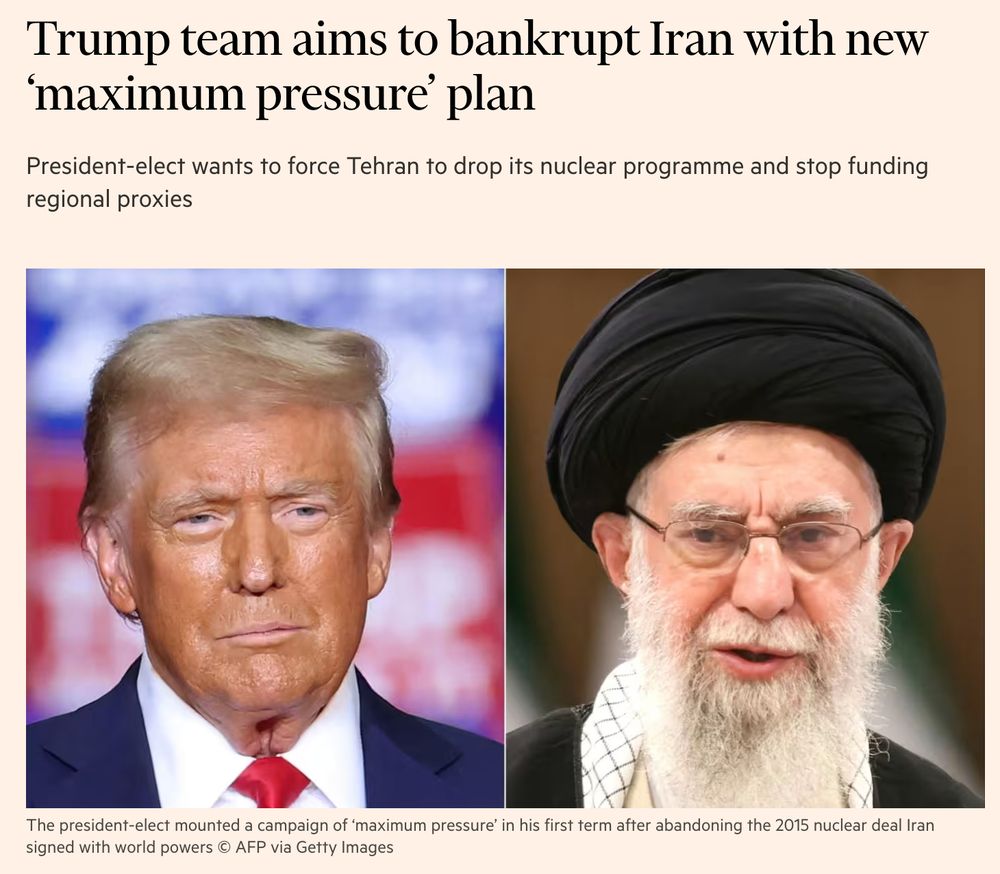
February 26, 2025 at 11:06 PM
In the US, amidst a demoralizing political news cycle, the Trump admin has reinitiated the Maximum Pressure strategy on Iran, imposing renewed sanctions.
Our findings suggest growing pressure on Iran could result in another wave of mass Afghan repatriation, further destabilizing Afghanistan.
Our findings suggest growing pressure on Iran could result in another wave of mass Afghan repatriation, further destabilizing Afghanistan.
For policy, a number of recent developments are relevant.
Several European countries are contemplating forcibly repatriating Syrian refugees. Achieving Syrian returns by restricting hosting conditions for Syrian refugees may exacerbate instability in Syrian areas that receive returnees from Europe.
Several European countries are contemplating forcibly repatriating Syrian refugees. Achieving Syrian returns by restricting hosting conditions for Syrian refugees may exacerbate instability in Syrian areas that receive returnees from Europe.
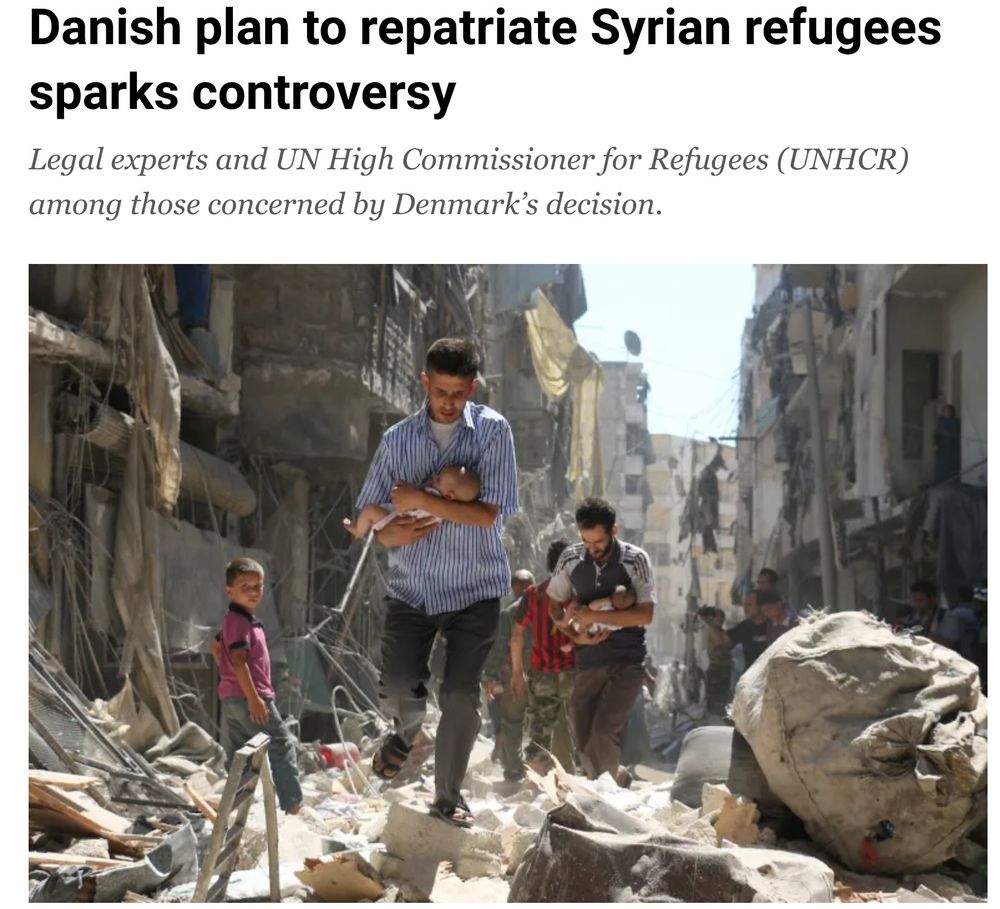
February 26, 2025 at 11:06 PM
For policy, a number of recent developments are relevant.
Several European countries are contemplating forcibly repatriating Syrian refugees. Achieving Syrian returns by restricting hosting conditions for Syrian refugees may exacerbate instability in Syrian areas that receive returnees from Europe.
Several European countries are contemplating forcibly repatriating Syrian refugees. Achieving Syrian returns by restricting hosting conditions for Syrian refugees may exacerbate instability in Syrian areas that receive returnees from Europe.
One possible reason is that there was nothing for returnees and their non-migrant neighbors to fight over, like parochial access of one group but not the other to aid, land, resources.
Another possibility is that strong local institutions in returnee-receiving areas mitigated conflict.
Another possibility is that strong local institutions in returnee-receiving areas mitigated conflict.

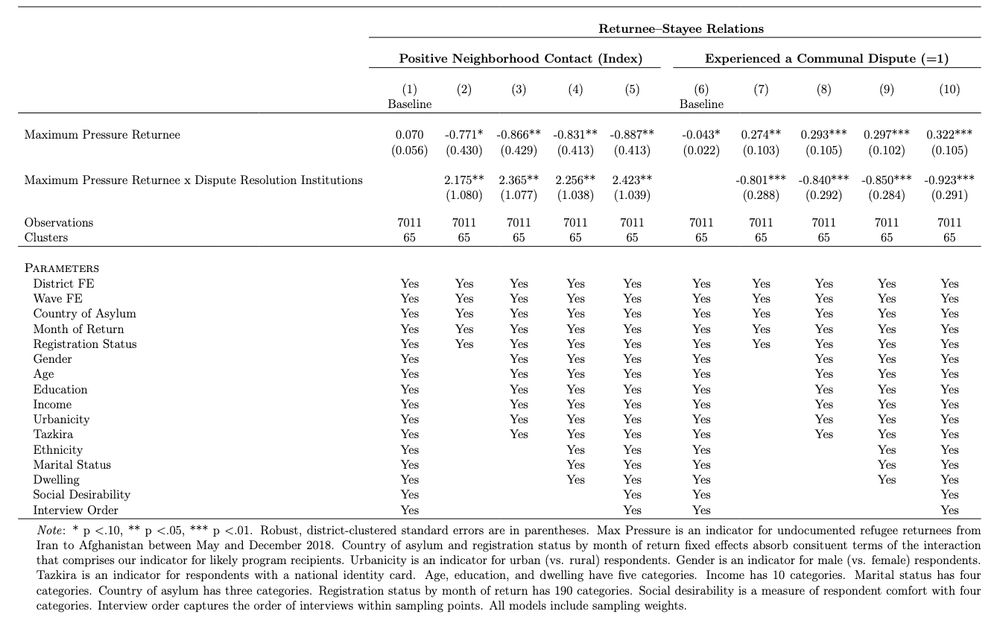
February 26, 2025 at 11:06 PM
One possible reason is that there was nothing for returnees and their non-migrant neighbors to fight over, like parochial access of one group but not the other to aid, land, resources.
Another possibility is that strong local institutions in returnee-receiving areas mitigated conflict.
Another possibility is that strong local institutions in returnee-receiving areas mitigated conflict.
What about communal violence?
Much prior evidence suggests mass repatriation increases communal disputes and local feuds.
To our surprise, we find no evidence that return was associated with ⬆️ communal conflict in this setting. If anything, returnees reported better relations.
Much prior evidence suggests mass repatriation increases communal disputes and local feuds.
To our surprise, we find no evidence that return was associated with ⬆️ communal conflict in this setting. If anything, returnees reported better relations.
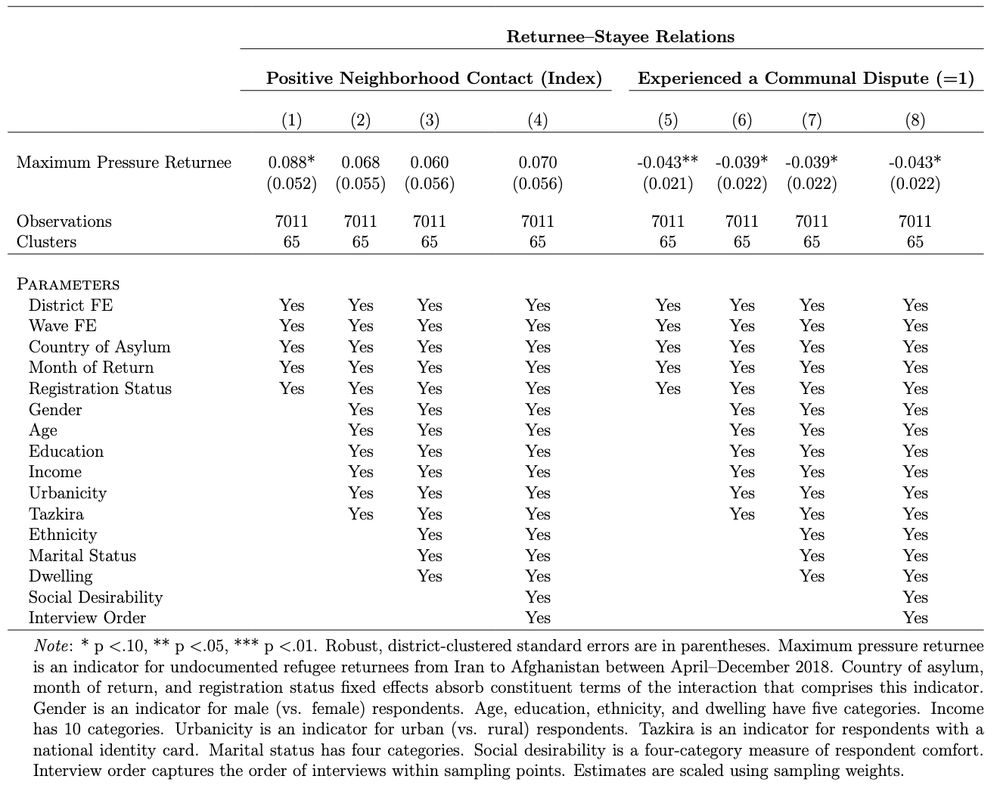

February 26, 2025 at 11:06 PM
What about communal violence?
Much prior evidence suggests mass repatriation increases communal disputes and local feuds.
To our surprise, we find no evidence that return was associated with ⬆️ communal conflict in this setting. If anything, returnees reported better relations.
Much prior evidence suggests mass repatriation increases communal disputes and local feuds.
To our surprise, we find no evidence that return was associated with ⬆️ communal conflict in this setting. If anything, returnees reported better relations.
We develop a new measure of Iranian covert support networks in Afghanistan, using FOIA-ed information on Iranian facilitation routes and arms trafficking.
Violence during the Max Pressure period ⬆️ disproportionately in returnee-receiving communities linked to Iran-backed Taliban cells
Violence during the Max Pressure period ⬆️ disproportionately in returnee-receiving communities linked to Iran-backed Taliban cells
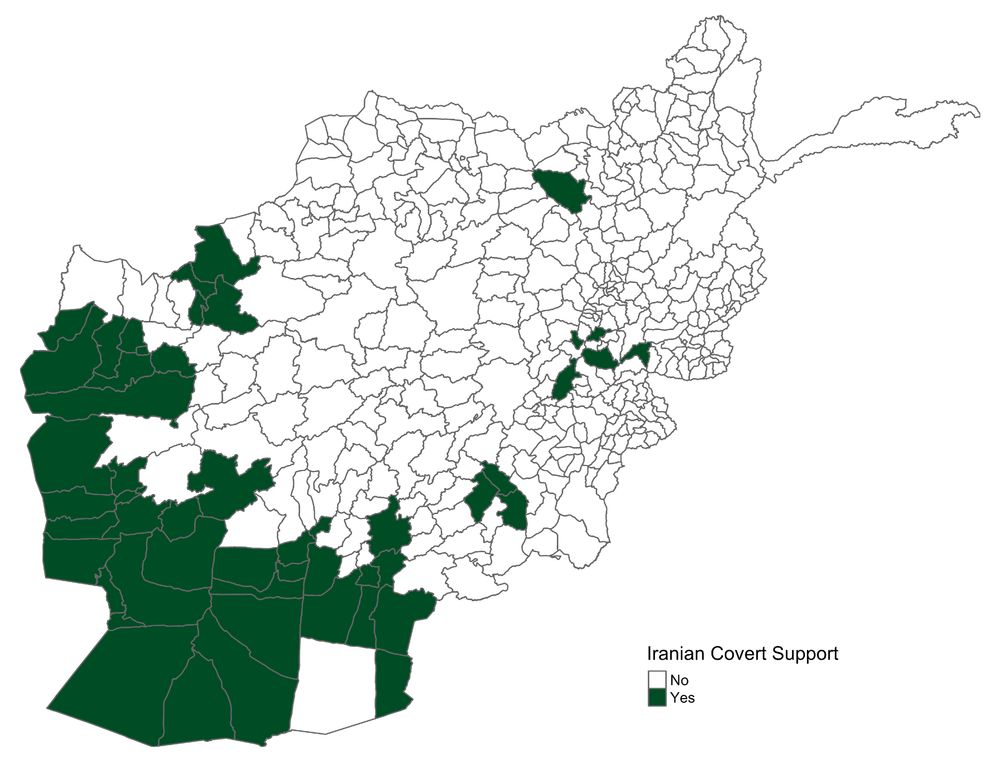
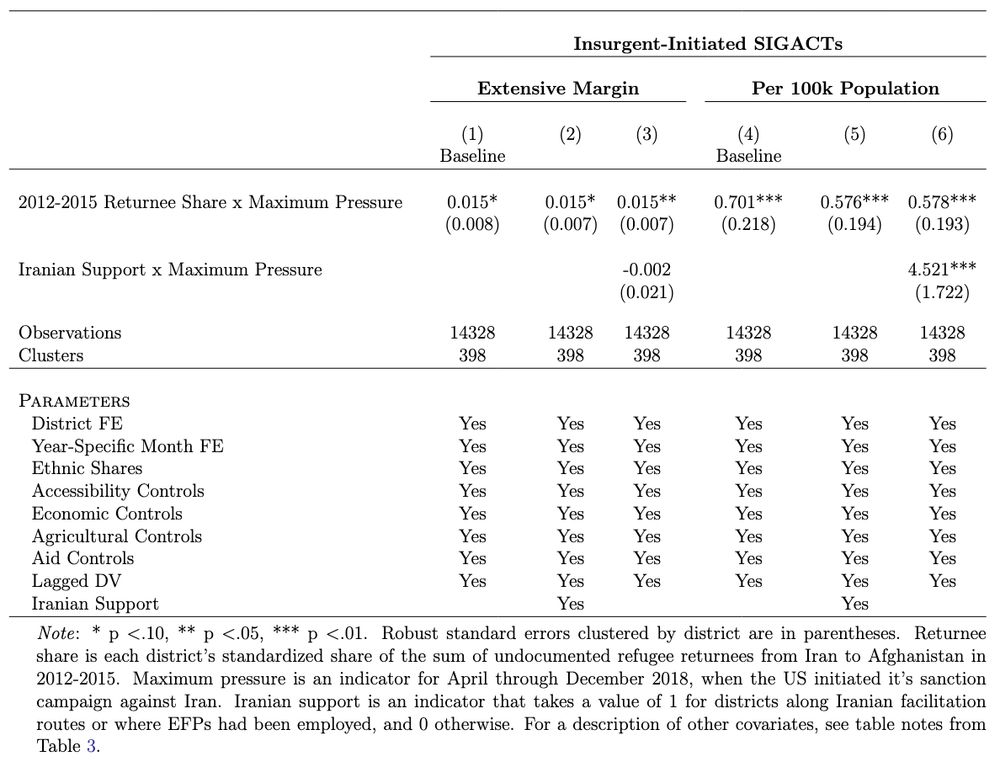
February 26, 2025 at 11:06 PM
We develop a new measure of Iranian covert support networks in Afghanistan, using FOIA-ed information on Iranian facilitation routes and arms trafficking.
Violence during the Max Pressure period ⬆️ disproportionately in returnee-receiving communities linked to Iran-backed Taliban cells
Violence during the Max Pressure period ⬆️ disproportionately in returnee-receiving communities linked to Iran-backed Taliban cells
We cannot directly observe Taliban recruitment designed to capitalize on these dynamics.
But: tactical shifts are suggestive. Insurgents flush with recruits can pull off riskier and deadlier ops using labor-intensive tactics (e.g., complex attacks) that require large teams of perps to conduct.
But: tactical shifts are suggestive. Insurgents flush with recruits can pull off riskier and deadlier ops using labor-intensive tactics (e.g., complex attacks) that require large teams of perps to conduct.
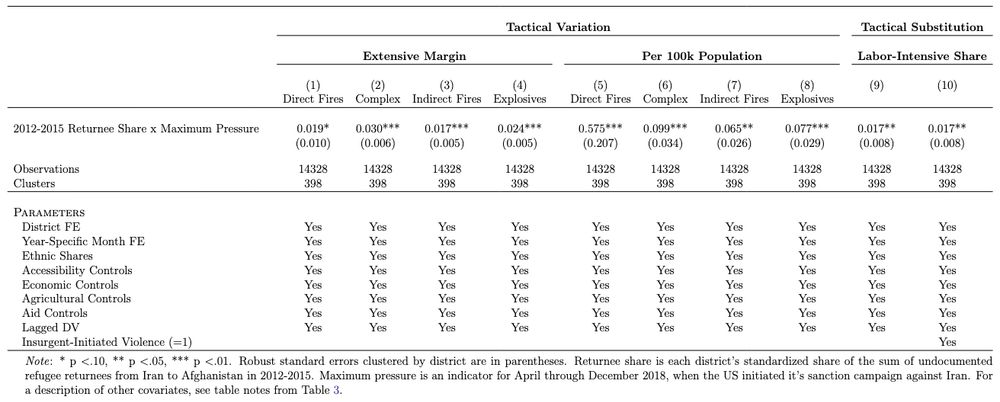
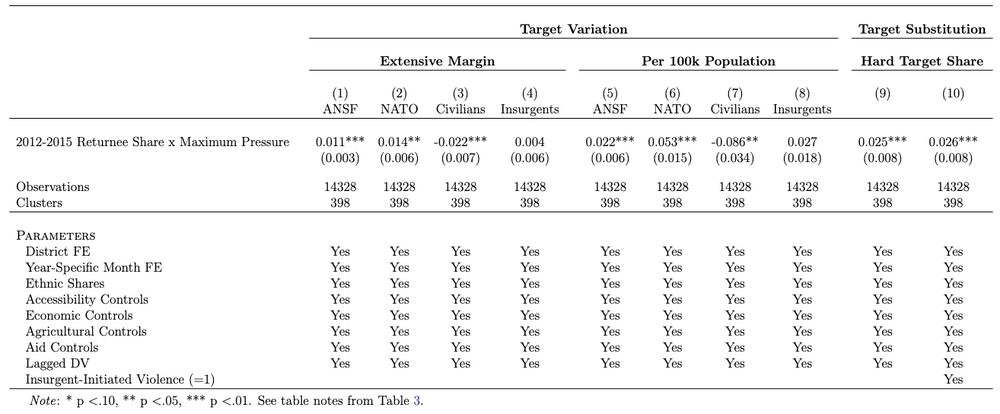

February 26, 2025 at 11:06 PM
We cannot directly observe Taliban recruitment designed to capitalize on these dynamics.
But: tactical shifts are suggestive. Insurgents flush with recruits can pull off riskier and deadlier ops using labor-intensive tactics (e.g., complex attacks) that require large teams of perps to conduct.
But: tactical shifts are suggestive. Insurgents flush with recruits can pull off riskier and deadlier ops using labor-intensive tactics (e.g., complex attacks) that require large teams of perps to conduct.
We find evidence consistent with this interpretation.
In returnee-receiving communities, there was ⬆️ unemployment, ⬇️ economic perceptions, and ⬇️ consumption (as measured by nighttime luminosity)
In returnee-receiving communities, there was ⬆️ unemployment, ⬇️ economic perceptions, and ⬇️ consumption (as measured by nighttime luminosity)
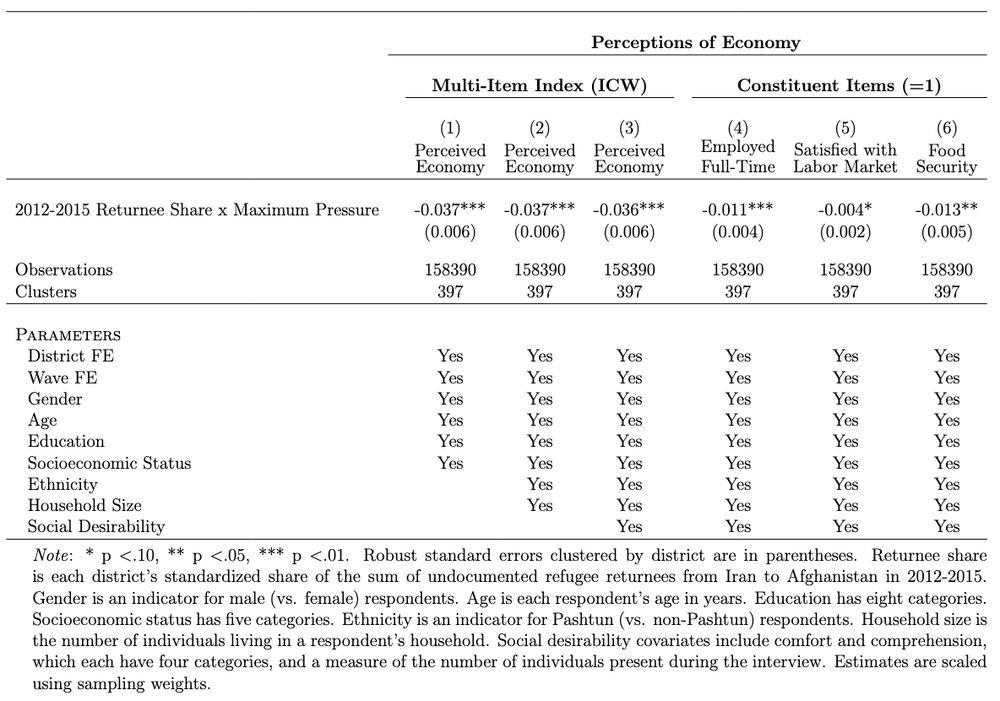
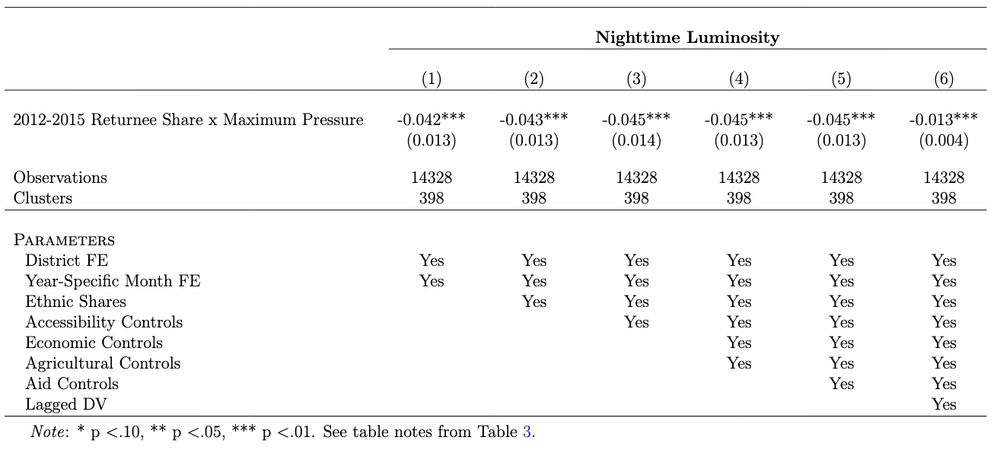
February 26, 2025 at 11:06 PM
We find evidence consistent with this interpretation.
In returnee-receiving communities, there was ⬆️ unemployment, ⬇️ economic perceptions, and ⬇️ consumption (as measured by nighttime luminosity)
In returnee-receiving communities, there was ⬆️ unemployment, ⬇️ economic perceptions, and ⬇️ consumption (as measured by nighttime luminosity)
US Defense Dept. officials foresaw this possibility, and noted that large-scale returns of destitute Afghan refugees to Afghanistan at a time when the Taliban was interested in recruiting part-time fighters for the summer offensive would make these individuals targets of recruitment.

February 26, 2025 at 11:06 PM
US Defense Dept. officials foresaw this possibility, and noted that large-scale returns of destitute Afghan refugees to Afghanistan at a time when the Taliban was interested in recruiting part-time fighters for the summer offensive would make these individuals targets of recruitment.
So how did the Maximum Pressure repatriation shock shape conflict in Afghanistan?
Militant violence ⬆️ drastically -- 2018 ended up as the single deadliest year of the conflict in Afghanistan from 2001-2021
Militant violence ⬆️ drastically -- 2018 ended up as the single deadliest year of the conflict in Afghanistan from 2001-2021
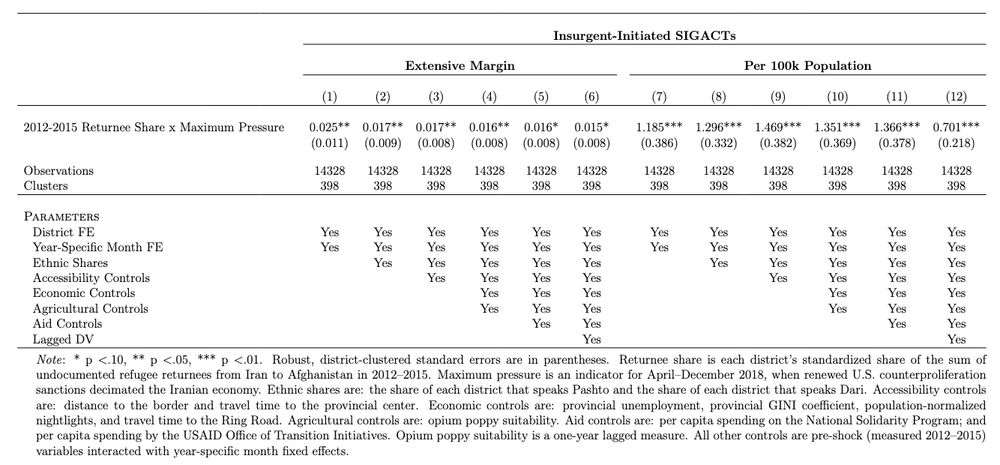
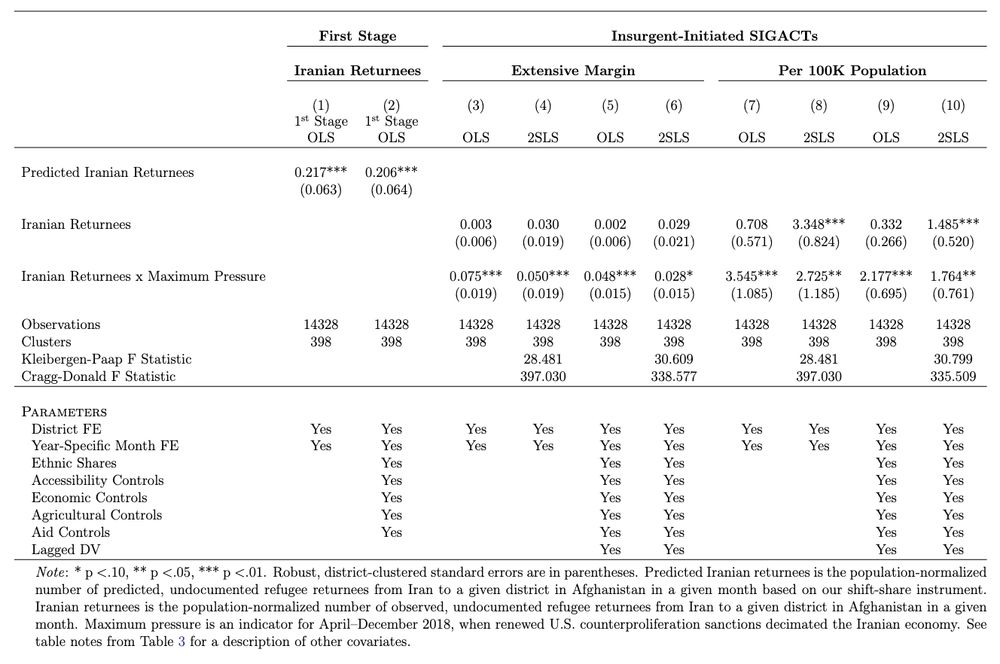
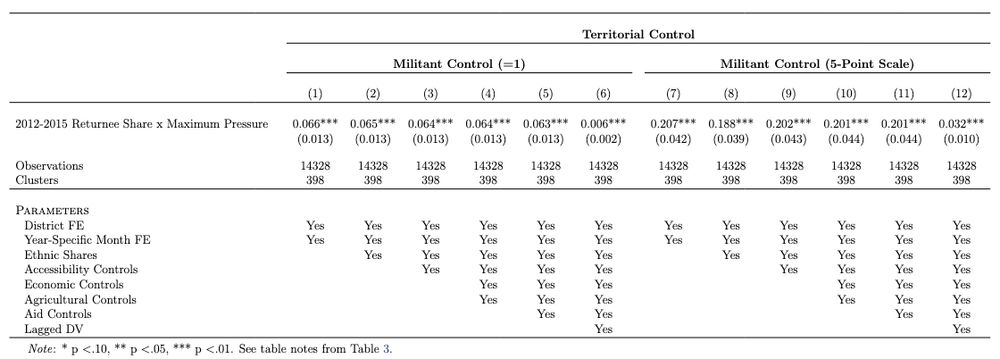
February 26, 2025 at 11:06 PM
So how did the Maximum Pressure repatriation shock shape conflict in Afghanistan?
Militant violence ⬆️ drastically -- 2018 ended up as the single deadliest year of the conflict in Afghanistan from 2001-2021
Militant violence ⬆️ drastically -- 2018 ended up as the single deadliest year of the conflict in Afghanistan from 2001-2021
Settlement locations of the 2018 Max Pressure returnees closely resemble settlement patterns of earlier waves of returnees from Iran in the 2012-2015 period
Combining geographic variation in exposure to returns and exogenous time-series variation coming from the sanctions policy shock we estimate:
Combining geographic variation in exposure to returns and exogenous time-series variation coming from the sanctions policy shock we estimate:


February 26, 2025 at 11:06 PM
Settlement locations of the 2018 Max Pressure returnees closely resemble settlement patterns of earlier waves of returnees from Iran in the 2012-2015 period
Combining geographic variation in exposure to returns and exogenous time-series variation coming from the sanctions policy shock we estimate:
Combining geographic variation in exposure to returns and exogenous time-series variation coming from the sanctions policy shock we estimate:
To understand how the unexpected return shock shaped the incidence of conflict in the Afghan communities to which refugees repatriated from Iran, we use novel data on historical returnee settlement patterns shared by the IOM
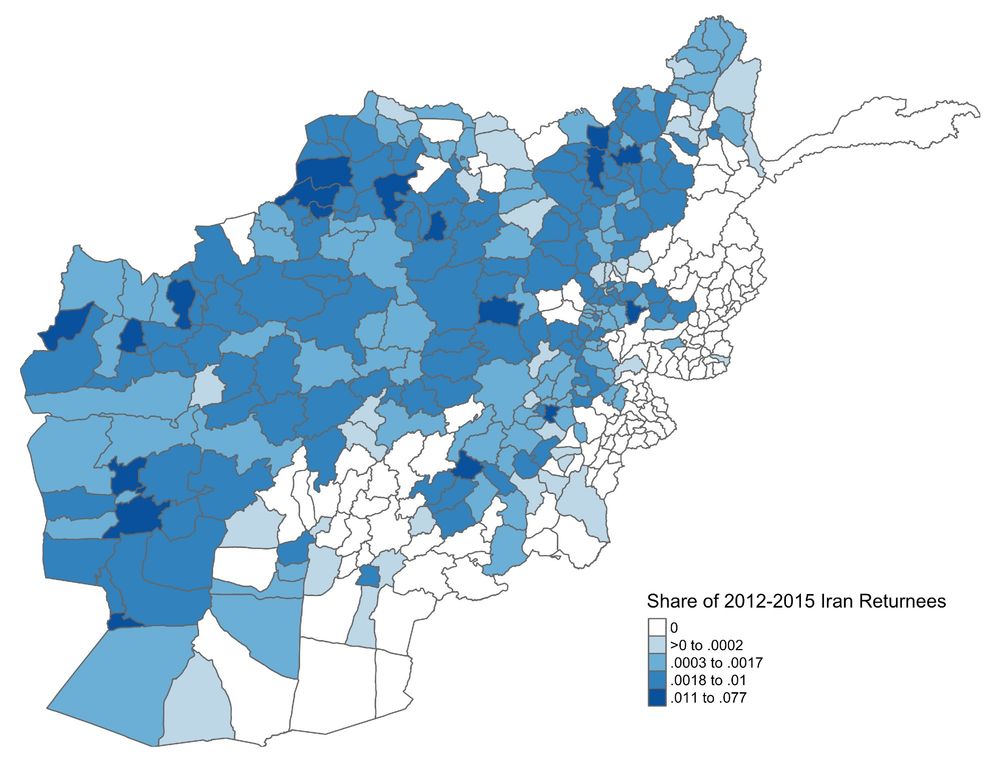

February 26, 2025 at 11:06 PM
To understand how the unexpected return shock shaped the incidence of conflict in the Afghan communities to which refugees repatriated from Iran, we use novel data on historical returnee settlement patterns shared by the IOM
So, the Max Pressure strategy spurred mass Afghan return in 2018, and this return owed to worsening conditions in Iran. Conditions in Afg. were not improving.
Critically, the pressure campaign escalated at the start of the Afghan fighting season, when the Taliban recruits for the summer offensive.
Critically, the pressure campaign escalated at the start of the Afghan fighting season, when the Taliban recruits for the summer offensive.


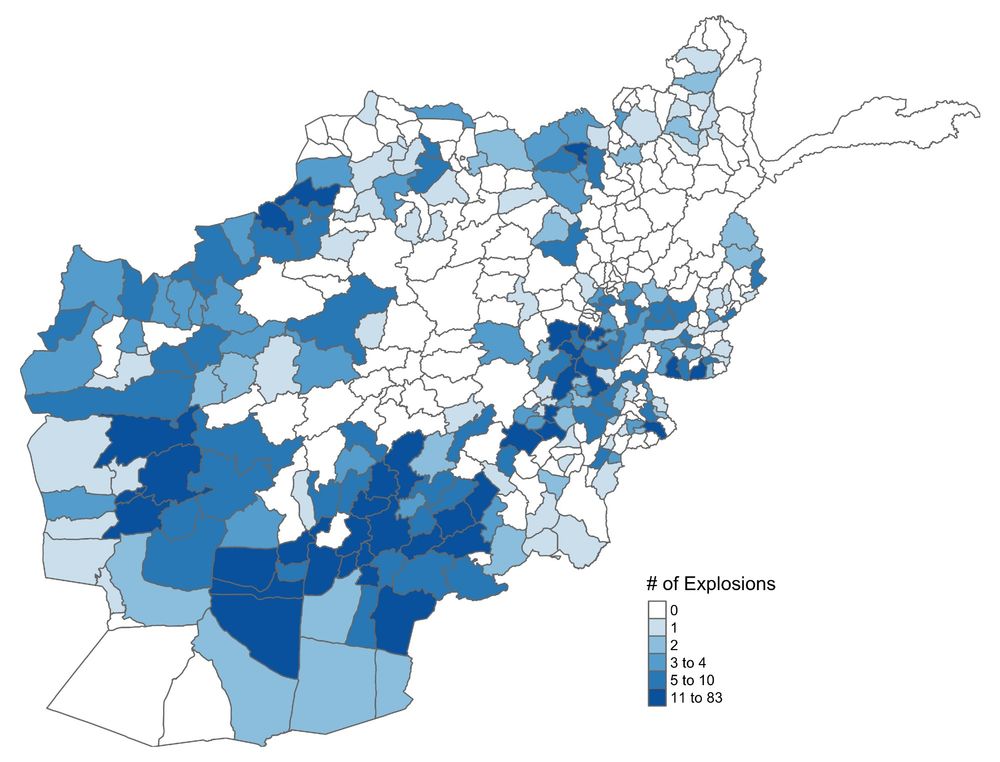
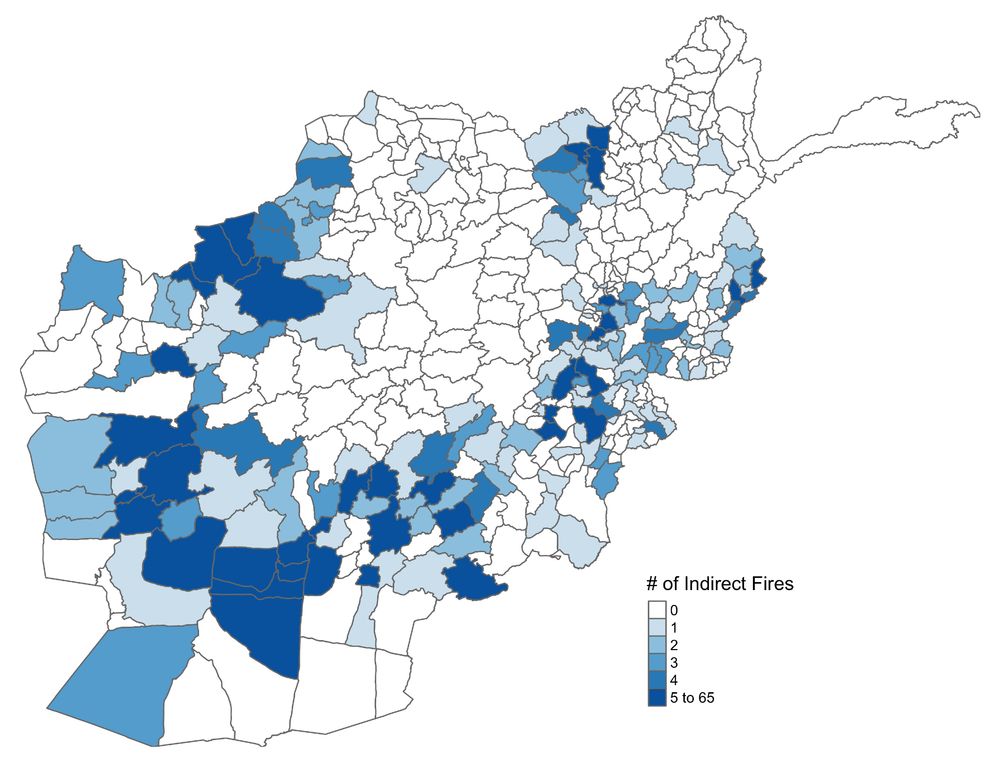
February 26, 2025 at 11:06 PM
So, the Max Pressure strategy spurred mass Afghan return in 2018, and this return owed to worsening conditions in Iran. Conditions in Afg. were not improving.
Critically, the pressure campaign escalated at the start of the Afghan fighting season, when the Taliban recruits for the summer offensive.
Critically, the pressure campaign escalated at the start of the Afghan fighting season, when the Taliban recruits for the summer offensive.
The Iranian Labour Force Survey and the Iranian Household
and Expenditure Survey show Afghan migrants in Iran reported ⬆️ unemployment, ⬇️ gross income, wage rate, hours worked during the Max Pressure period.
In a survey of returnees, Afghans report leaving precisely b/c of negative economy in Iran
and Expenditure Survey show Afghan migrants in Iran reported ⬆️ unemployment, ⬇️ gross income, wage rate, hours worked during the Max Pressure period.
In a survey of returnees, Afghans report leaving precisely b/c of negative economy in Iran



February 26, 2025 at 11:06 PM
The Iranian Labour Force Survey and the Iranian Household
and Expenditure Survey show Afghan migrants in Iran reported ⬆️ unemployment, ⬇️ gross income, wage rate, hours worked during the Max Pressure period.
In a survey of returnees, Afghans report leaving precisely b/c of negative economy in Iran
and Expenditure Survey show Afghan migrants in Iran reported ⬆️ unemployment, ⬇️ gross income, wage rate, hours worked during the Max Pressure period.
In a survey of returnees, Afghans report leaving precisely b/c of negative economy in Iran
3 million Afghan migrants and refugees resided in Iran at the time, mostly working in cash-based jobs in the informal sector (e.g., construction, street vendors).
Currency depreciation disproportionately affected Afghans in Iran.
Unintended consequence: 618,000+ Afghans repatriated from Iran
Currency depreciation disproportionately affected Afghans in Iran.
Unintended consequence: 618,000+ Afghans repatriated from Iran


February 26, 2025 at 11:06 PM
3 million Afghan migrants and refugees resided in Iran at the time, mostly working in cash-based jobs in the informal sector (e.g., construction, street vendors).
Currency depreciation disproportionately affected Afghans in Iran.
Unintended consequence: 618,000+ Afghans repatriated from Iran
Currency depreciation disproportionately affected Afghans in Iran.
Unintended consequence: 618,000+ Afghans repatriated from Iran
To test this theory we study the Maximum Pressure sanctions imposed by the Trump Administration on Iran in 2018.
After pulling out of the Iran nuclear deal (JCPOA), the admin leveled sweeping counterproliferation sanctions on Iran, decimating the Iranian economy.
After pulling out of the Iran nuclear deal (JCPOA), the admin leveled sweeping counterproliferation sanctions on Iran, decimating the Iranian economy.




February 26, 2025 at 11:06 PM
To test this theory we study the Maximum Pressure sanctions imposed by the Trump Administration on Iran in 2018.
After pulling out of the Iran nuclear deal (JCPOA), the admin leveled sweeping counterproliferation sanctions on Iran, decimating the Iranian economy.
After pulling out of the Iran nuclear deal (JCPOA), the admin leveled sweeping counterproliferation sanctions on Iran, decimating the Iranian economy.
We develop a theory linking the consequences of refugee return with the context within which it occurs.
We specifically argue that refugees repatriating b/c of negative conditions in a host country are likely to lack econ and social resources needed for reintegration. This increases conflict risks
We specifically argue that refugees repatriating b/c of negative conditions in a host country are likely to lack econ and social resources needed for reintegration. This increases conflict risks

February 26, 2025 at 11:06 PM
We develop a theory linking the consequences of refugee return with the context within which it occurs.
We specifically argue that refugees repatriating b/c of negative conditions in a host country are likely to lack econ and social resources needed for reintegration. This increases conflict risks
We specifically argue that refugees repatriating b/c of negative conditions in a host country are likely to lack econ and social resources needed for reintegration. This increases conflict risks
Why return to a fragile, dangerous origin country?
Often, refugees have no choice. If anti-refugee policy restrictions, economic recessions, or xenophobia makes refugee hosting conditions sufficiently severe, refugees might repatriate despite the risks.
Often, refugees have no choice. If anti-refugee policy restrictions, economic recessions, or xenophobia makes refugee hosting conditions sufficiently severe, refugees might repatriate despite the risks.

February 26, 2025 at 11:06 PM
Why return to a fragile, dangerous origin country?
Often, refugees have no choice. If anti-refugee policy restrictions, economic recessions, or xenophobia makes refugee hosting conditions sufficiently severe, refugees might repatriate despite the risks.
Often, refugees have no choice. If anti-refugee policy restrictions, economic recessions, or xenophobia makes refugee hosting conditions sufficiently severe, refugees might repatriate despite the risks.
The third case -- when large-scale returns occur to fragile origin countries despite ongoing violence and absent aid-based incentives to repatriate -- is overlooked in existing work.
76% of refugee returnees actually repatriate to origin countries suffering significant ongoing conflicts
76% of refugee returnees actually repatriate to origin countries suffering significant ongoing conflicts

February 26, 2025 at 11:06 PM
The third case -- when large-scale returns occur to fragile origin countries despite ongoing violence and absent aid-based incentives to repatriate -- is overlooked in existing work.
76% of refugee returnees actually repatriate to origin countries suffering significant ongoing conflicts
76% of refugee returnees actually repatriate to origin countries suffering significant ongoing conflicts
We outline three contexts within which mass return occurs:
1) the ideal-typical case of return when conditions at origin improve
2) cases where mobility costs are exogenously reduced, for instance because of aid inducements
3) cases where returns happen simply b/c of worsening hosting conditions
1) the ideal-typical case of return when conditions at origin improve
2) cases where mobility costs are exogenously reduced, for instance because of aid inducements
3) cases where returns happen simply b/c of worsening hosting conditions

February 26, 2025 at 11:06 PM
We outline three contexts within which mass return occurs:
1) the ideal-typical case of return when conditions at origin improve
2) cases where mobility costs are exogenously reduced, for instance because of aid inducements
3) cases where returns happen simply b/c of worsening hosting conditions
1) the ideal-typical case of return when conditions at origin improve
2) cases where mobility costs are exogenously reduced, for instance because of aid inducements
3) cases where returns happen simply b/c of worsening hosting conditions
Access to other of the so-called "durable solutions" is also collapsing. Fewer than 1% of refugees are naturalized into developing host countries or resettled in safe third countries countries in any given year.
"Displacement is outpacing solutions for those on the run."
-Filippo Grandi (UNHCR)
"Displacement is outpacing solutions for those on the run."
-Filippo Grandi (UNHCR)


February 26, 2025 at 11:06 PM
Access to other of the so-called "durable solutions" is also collapsing. Fewer than 1% of refugees are naturalized into developing host countries or resettled in safe third countries countries in any given year.
"Displacement is outpacing solutions for those on the run."
-Filippo Grandi (UNHCR)
"Displacement is outpacing solutions for those on the run."
-Filippo Grandi (UNHCR)
Refugee repatriation is the international community's preferred solution to displacement crises. In the ideal case, refugees return home to their origin countries when conflict ends
But displacement is starkly outpacing repatriation. Since 2013, fewer than 4% of refugees have been able to return
But displacement is starkly outpacing repatriation. Since 2013, fewer than 4% of refugees have been able to return

February 26, 2025 at 11:06 PM
Refugee repatriation is the international community's preferred solution to displacement crises. In the ideal case, refugees return home to their origin countries when conflict ends
But displacement is starkly outpacing repatriation. Since 2013, fewer than 4% of refugees have been able to return
But displacement is starkly outpacing repatriation. Since 2013, fewer than 4% of refugees have been able to return
🚨🚨🚨🚨 New WP (with @benckrick.bsky.social @austinlw.bsky.social) available at the ESOC working paper series:
esoc.princeton.edu/wp39
esoc.princeton.edu/wp39
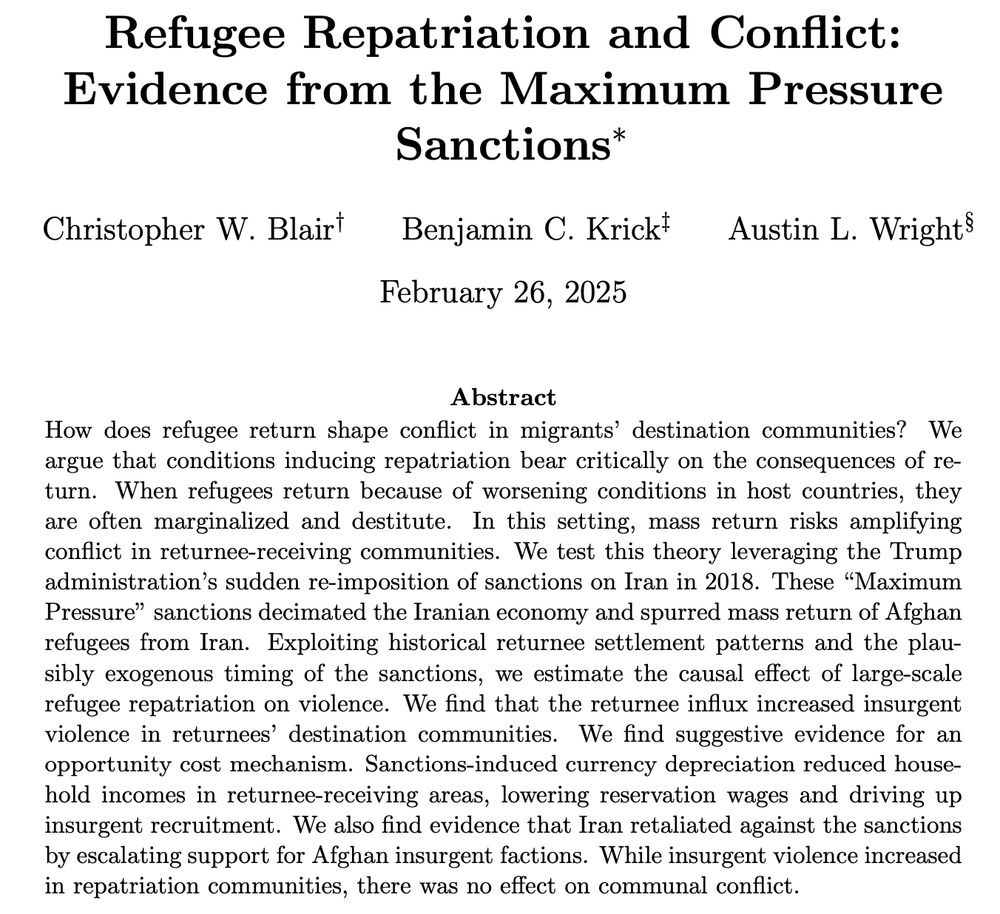
February 26, 2025 at 11:06 PM
🚨🚨🚨🚨 New WP (with @benckrick.bsky.social @austinlw.bsky.social) available at the ESOC working paper series:
esoc.princeton.edu/wp39
esoc.princeton.edu/wp39
These results survive robustness checks including alternative measures of exposure and alternative weights, clusters, and estimators.
But do effects persist longer than the 4 post-storm weeks our initial survey covered? A 6-month follow-up survey reveals no long-run impacts.
But do effects persist longer than the 4 post-storm weeks our initial survey covered? A 6-month follow-up survey reveals no long-run impacts.


November 19, 2024 at 7:00 PM
These results survive robustness checks including alternative measures of exposure and alternative weights, clusters, and estimators.
But do effects persist longer than the 4 post-storm weeks our initial survey covered? A 6-month follow-up survey reveals no long-run impacts.
But do effects persist longer than the 4 post-storm weeks our initial survey covered? A 6-month follow-up survey reveals no long-run impacts.
There is exploratory evidence that these effects are not merely attitudinal. In areas more exposed to Hurricane Ian, voters were more supportive of a climate adaptation-related ballot measure in the 2022 Florida general election.

November 19, 2024 at 7:00 PM
There is exploratory evidence that these effects are not merely attitudinal. In areas more exposed to Hurricane Ian, voters were more supportive of a climate adaptation-related ballot measure in the 2022 Florida general election.
We also find large, distinguishable increases in support for climate mitigation and belief in climate science in hurricane-affected counties.

November 19, 2024 at 7:00 PM
We also find large, distinguishable increases in support for climate mitigation and belief in climate science in hurricane-affected counties.

